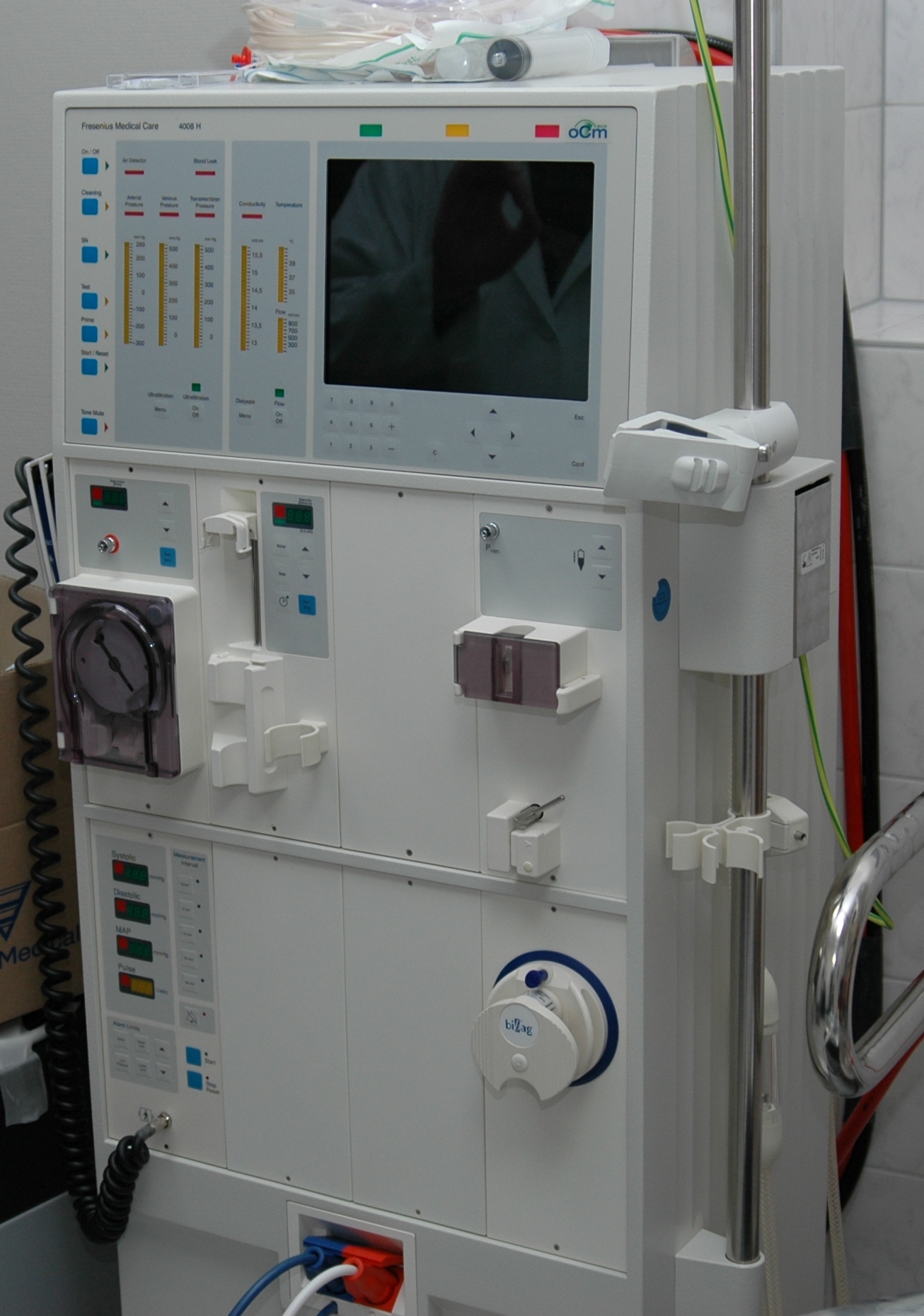
Kidney failure
Kidney failure, also known as end-stage renal disease (ESRD), is a medical condition in which the kidneys can no longer adequately filter waste products from the blood, functioning at less than 15% of normal levels.[2] Kidney failure is classified as either acute kidney failure, which develops rapidly and may resolve; and chronic kidney failure, which develops slowly and can often be irreversible.[6] Symptoms may include leg swelling, feeling tired, vomiting, loss of appetite, and confusion.[2] Complications of acute and chronic failure include uremia, hyperkalemia, and volume overload.[3] Complications of chronic failure also include heart disease, high blood pressure, and anaemia.[4][5]
Kidney failure
Renal failure, end-stage renal disease (ESRD), stage 5 chronic kidney disease[1]
Leg swelling, feeling tired, loss of appetite, confusion[2]
Acute: Uremia, high blood potassium, volume overload[3]
Chronic: Heart disease, high blood pressure, anemia[4][5]
Acute:
- Low blood pressure
- blockage of the urinary tract
- certain medications
- muscle breakdown
- hemolytic uremic syndrome
Chronic: [6]
Acute: Depends on the cause[7]
Chronic: Hemodialysis, peritoneal dialysis, kidney transplant[2]
Causes of acute kidney failure include low blood pressure, blockage of the urinary tract, certain medications, muscle breakdown, and hemolytic uremic syndrome.[6] Causes of chronic kidney failure include diabetes, high blood pressure, nephrotic syndrome, and polycystic kidney disease.[6] Diagnosis of acute failure is often based on a combination of factors such as decreased urine production or increased serum creatinine.[3] Diagnosis of chronic failure is based on a glomerular filtration rate (GFR) of less than 15 or the need for renal replacement therapy.[1] It is also equivalent to stage 5 chronic kidney disease.[1]
Treatment of acute failure depends on the underlying cause.[7] Treatment of chronic failure may include hemodialysis, peritoneal dialysis, or a kidney transplant.[2] Hemodialysis uses a machine to filter the blood outside the body.[2] In peritoneal dialysis specific fluid is placed into the abdominal cavity and then drained, with this process being repeated multiple times per day.[2] Kidney transplantation involves surgically placing a kidney from someone else and then taking immunosuppressant medication to prevent rejection.[2] Other recommended measures from chronic disease include staying active and specific dietary changes.[2] Depression is also common among patients with kidney failure, and is associated with poor outcomes including higher risk of kidney function decline, hospitalization, and death. A recent PCORI-funded study of patients with kidney failure receiving outpatient hemodialysis found similar effectiveness between nonpharmacological and pharmacological treatments for depression.[9]
In the United States, acute failure affects about 3 per 1,000 people a year.[8] Chronic failure affects about 1 in 1,000 people with 3 per 10,000 people newly developing the condition each year.[1][10] Acute failure is often reversible while chronic failure often is not.[6] With appropriate treatment many with chronic disease can continue working.[2]
Symptoms can vary from person to person. Someone in early stage kidney disease may not feel sick or notice symptoms as they occur. When the kidneys fail to filter properly, waste accumulates in the blood and the body, a condition called azotemia. Very low levels of azotaemia may produce few, if any, symptoms. If the disease progresses, symptoms become noticeable (if the failure is of sufficient degree to cause symptoms). Kidney failure accompanied by noticeable symptoms is termed uraemia.[17]
Symptoms of kidney failure include the following:[17][18][19][20]
Complications[edit]
Those with end stage renal failure who undergo haemodialysis have higher risk of spontaneous intra-abdominal bleeding than the general population (21.2%) and non-occlusive mesenteric ischemia (18.1%). Meanwhile, those undergoing peritoneal dialysis have a higher chance of developing peritonitis and gastrointestinal perforation. However, the rate of acute pancreatitis does not differ from the general population.[37]